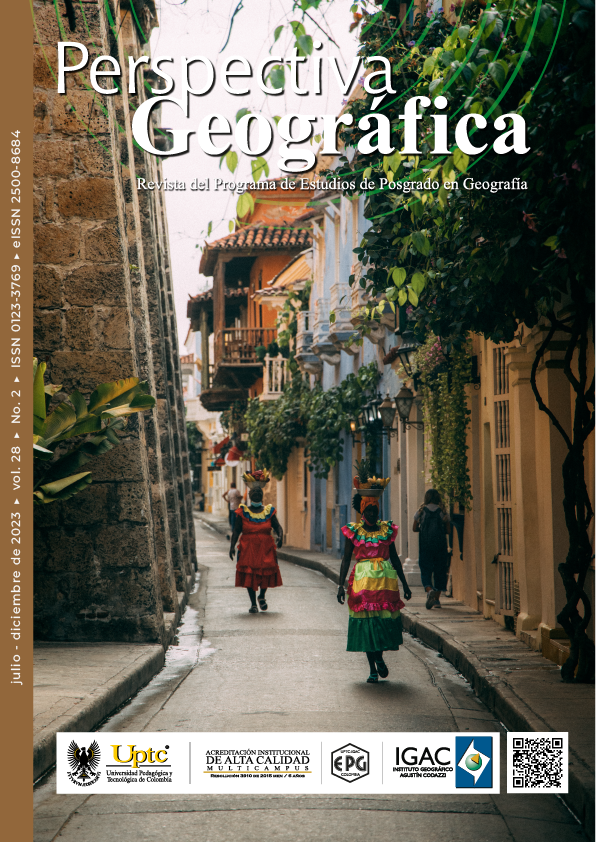The tenant phenomenon in intermediate cities: actors, values and tenant supply in the metropolitan area of Mendoza, Argentina

Abstract
The rapid growth of tenant households in the main cities of Latin America has gone hand in hand with the decrease in owner households since the late 1990s. It is observed that the tenant households are condensed in the central areas of the cities where there has been a process of urban densification and there is greater sedimentation of the housing supply. In the Metropolitan Area of Mendoza (AMM), constituted as an agglomerate of intermediate size, this phenomenon called “tenancy process” is also reproduced. The territorial configuration
of urban expansion is expressed in the “commodification” of the city, due to the valuation and conversion of urban land, into a real estate and financial business in which housing is a commodity and its accessibility is associated with purchasing power. of each home. The tenant reality of the AMM is analysed, based on the population growth between census periods, and the distribution in the urban territory. The tenancy phenomenon is analysed by the level of socio-housing vulnerability of tenant households on the relationship between rental values and income of the population. The methodology is inductive-explanatory, and combines documentary analysis techniques from primary and secondary sources, interviews, and quantitative measurement processes. The data is built by own consultation, census information and local real estate portals. As a result, it was obtained that the central departments of the AMM are mostly affected by the tenancy process and a greater degree of vulnerability.
Keywords
intermediates cities, commodification, tenacy process, tenant vulneraty, rentals, geography
Author Biography
Virginia Miranda Gassull
Doctora en Ordenamiento Territorial y Desarrollo Sostenible (UNCuyo). Instituto de Ambiente, Hábitat y Energía (INAHE). Consejo Nacional de Investigaciones Científicas y Técnicas (Conicet). CEHA-FCPyS (UNCuyo) y Docente FI-UNCuyo y FI-UMAZA.
Florencia Ginestar
Arquitecta (UNCuyo). Instituto de Ambiente, Hábitat y Energía (INAHE). Consejo Nacional de Investigaciones Científicas y Técnicas (Conicet). Centro de Estudios del Hábitat Humano (CEHA, FCPyS, UNCuyo). Carrera de Arquitectura (FI, UNCuyo).
References
- Aalbers, M. (2016). Financialization of housing: A political economy approach. Routledge.
- Bellet, C. & Llop, J. M. (2003). Ciudades intermedias. Perfiles y pautas. Segunda fase del programa “Ciudades intermedias y urbanización mundial”. Milenio. http://www.ceut.udl.cat/wp-content/uploads/6.BOOK2_.pdf
- Blanco, A., Fretes Cibils, V., & Muñoz, A. F. (2014). Se busca vivienda en alquiler: opciones de política para América Latina y el Caribe. [Monografía n° 181]. Banco Interamericano de Desarrollo. https://publications.iadb.org/publications/spanish/document/Se-busca-vivienda-en-alquiler-Opciones-de-pol%C3%ADtica-en-Am%C3%A9rica-Latina-y-el-Caribe.pdf
- Escuela Interdisciplinaria de Altos Estudios Sociales (IDAES) & Centro de Estudios Legales y Sociales (CELS) (2021). El índice de vulnerabilidad inquilina (IVI). IDAES; CELS. https://www.cels.org.ar/web/publicaciones/el-indice-de-vulnerabilidad-inquilina-ivi-de-la-escuela-idaes-unsam-y-el-cels/
- Fields, D. & Uber, S. (2014). The financialization of rental housing: A comparative analysis of New York City and Berlin. Urban Studies, 53(7), 1486-1502. https://www.jstor.org/stable/26151125
- García-Montalvo, J. (2019). Retos del mercado del alquiler en España. Cuadernos de Información Económica, 269, 1-11.
- Haffner, M. & Hulse, K. (2021) Una nueva mirada a las perspectivas contemporáneas sobre la asequibilidad de la vivienda urbana. International Journal of Urban Sciences, 25(sup. 1), 59-79. doi: 10.1080/12265934.2019.1687320.
- Kaztman, R. (2018). Reflexiones en torno a las metástasis de las desigualdades en las estructuras educativas latinoamericanas. Cadernos Metrópole, 20(43). https://doi.org/10.1590/2236-9996.2018-4309
- Kaztman, R. (2020). Notas sobre la medición de la vulnerabilidad social. En Quinto Taller Regional sobre la Medición de la Pobreza: métodos y aplicaciones (pp. 275-301). Cepal.
- Link, F., Marín Toro, A., & Valenzuela, F. (2019). Geografías del arriendo en Santiago de Chile. De la vulnerabilidad residencial a la seguridad de tenencia. Economía, Sociedad y Territorio, 19(61), 507-542. https://doi.org/10.22136/est20191355
- Manzano, F. & Velázquez, G. (2015). La evolución de las ciudades intermedias en la Argentina. Geo UERJ, 27, 258-282. doi:https://doi.org/10.12957/geouerj.2015.18859
- Miranda Gassull, V. & Ginestar, F. (2022) La precarización habitacional, ¿frontera sociourbana? En J. Dalla Torre, R. Sales & J. Quiroga Ríos (compiladores), Las fronteras en la vida cotidiana de las ciudades neoliberales (pp. 209-231). Teseo. https://www.teseopress.com/lasfronterasenlavidacotidianadelasciudadesneoliberales
- Nievas, C. (2021). Capítulo 1. Resumen histórico sobre normativas de alquiler en Argentina. En D. Gargantini (ed.), La vivienda de alquiler como opción para habitar (1ª ed., pp. 17-43). Café de las Ciudades.
- Pírez, P. (2013). La urbanización y la política de los servicios urbanos en América Latina. Andamios, 10(22), 45-67.
- Rodríguez, M. C., Rodríguez, M. F., & Zapata, M. C. (2018). Mercantilización y expansión de la inquilinización informal en villas de Buenos Aires, Argentina. Revista INVI, 33(93), 125-150, 25-150. http://dx.doi.org/10.4067/S0718-83582018000200125.
- Rolnik, R. (2021). La guerra de los lugares. La colonización de la tierra y la vivienda en la era de las finanzas (1ª ed.). El Colectivo.
- Sassen, S. (2015). Expulsiones. Brutalidad y complejidad en la economía global. Katz. https://doi.org/10.2307/j.ctvm7bdqr
- Usach, N. & Garrido Yserte, R. (2009). Globalización y ciudades en América Latina: ¿es el turno de las ciudades intermedias en la Argentina? Documentos y Aportes en Administración Pública y Gestión Estatal, 13, 7-38. https://doi.org/10.14409/da.v1i13.1247
- Vapñarsky, C. A. & Gorojovsky, N. (1990). El crecimiento urbano en Argentina. Grupo Editor Latinoamericano.
- Otros documentos consultados
- Banco Interamericano de Desarrollo (BID) (2015). El universo de ciudades emergentes en América Latina y el Caribe. [Blog]. BID. https://blogs.iadb.org/ciudades-sostenibles/es/universo-de-ciudades-emergentes/
- Diario El Sol (25 de agosto del 2006). Ofrecen créditos a 30 años a inquilinos. Diario El Sol. https://www.elsol.com.ar/ofrecen-creditos-a-30-anos-a-inquilinos.html
- Diario Los Andes (22 de agosto de 2017). El boom de los alquileres temporarios en Mendoza. Los Andes. https://www.losandes.com.ar/por-la-alta-rentabilidad-crecen-los-alquileres-temporarios/
- Diario Los Andes (7 de marzo de 2022). Alta demanda de alquileres temporarios: Mendoza por $6.500 la noche. Los Andes. https://www.losandes.com.ar/economia/alta-demanda-de-alquileres-temporarios-mendoza-por-6500-la-noche/
- Instituto Nacional de Estadística y Censos (INDEC) (2019). Indicadores de condiciones de vida de los hogares en 31 aglomerados urbanos. Segundo semestre de 2019. [Informe técnico, Condiciones de vida, vol. 4, n° 6]. https://www.indec.gob.ar/uploads/informesdeprensa/eph_indicadores_hogares_02_194FEEBEB8E1.pdf
- Instituto Nacional de Estadística y Censos (INDEC) (2021). Mercado de trabajo. Tasas e indicadores socioeconómicos (EPH). Cuarto trimestre de 2021. [Informe técnico Trabajo e ingresos, vol. 6, n° 2]. https://www.indec.gob.ar/uploads/informesdeprensa/mercado_trabajo_eph_4trim211A57838DEC.pdf
- ONU-Habitat (2017). Nueva Agenda Urbana. Naciones Unidas. https://onuhabitat.org.mx/index.php/la-nueva-agenda-urbana-en-espanol